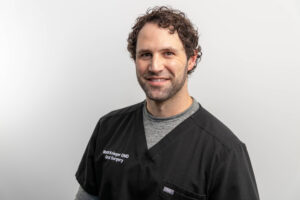Archived Newsletter Re-Post.
The AOX Newsletter • March 2024 #11
The atrophic jaw often presents significant challenges for All-On-X surgeons. This is especially true in the setting of immediately loaded prosthetics.
Not only can these cases be difficult clinically, but they can also be just plain intimidating.
Despite this added surgical stress, successful management of severely atrophic patients is often extremely rewarding for both the patient and the surgeon. However, these surgeries can be equally frustrating when things don’t go as planned.
Below, I will discuss 3 surgical pearls regarding management of atrophic AOX cases. These are techniques that, well… I’ve learned the hard way. My hope is that you don’t have to.
3 Surgical Pearls for the Atrophic Jaw
1. Fully-prepare, and occasionally over-prepare, your osteotomy sites.
One common misconception is that atrophy equals low density. Similarly, it is often thought that surgeons will have difficulty generating torque in atrophic jaws. While this definitely can occur from time to time, the norm is actually the opposite. In reality, severely atrophic jaws will often torque well and even excessively high.
Why? This is because the atrophy they have experienced has diiminised the less dense cancellous bone volume and what remains are the cortical portions of the ridge. Therefore, even though you may only have a 2, 3, or 4 mm ridge, you will be engaging almost exclusively cortical bone. Even on the “less dense” maxilla, in the setting of severe atrophy you will be engaging dense palatal bone in addition to the cortical plates.
As a result, in my experience a full preparation of the osteotomy is required in these cases. I do not under-prep. I prepare a full 3.5 mm osteotomy and place a 3.5 mm wide, tapered implant. There are even times on the mandible, which typically presents with greater density than the maxilla, where I will over-prepare the osteotomy sites with a 3.5+ drill or even a 4.0 mm drill at the crest.
The benefit to this technique is that it prevents an out-fracture of the buccal plate.
In atrophic cases, under-preparation of osteotomy sites leads to a significant risk of out-fracture of the buccal plate. Due to the cortical nature of the atrophic bone, high torque values can be generated and the bone simply does not have the width to sustain these values. This will lead to out-fracture.
Full osteotomy preparation in the maxilla and mandible (with occasional over-preparation) will prevent out-fracture of the buccal plate and still provide torque values that can be immediately loaded.
2. Don’t get greedy for high torque values.
In a routine AOX case I almost always under-prepare my osteotomies to some extent in order to improve torque. In these “non-atrophic” cases, I attempt to reach a target torque value of 45-60 N-cm.
However, as discussed above, in an attempt to prevent out-fracture in severely atrophic patients – I am NOT under-preparing my osteotomies as I would in a routine case. I am actually trying to avoid significantly increasing torque.
In these atrophic patients then – what torque value I am shooting for?
I attempt to obtain a torque value of 30-45 N-cm. Have I gone higher, yes. Has this worked? Sometimes. Have I out-fractured a buccal plate? More than once…
I’ve admittedly even fractured an entire anterior nasal spine and lost all torque in the anterior maxilla. These out-fractures, however, have always occurred at a torque value higher than 45 N-cm.
I’ve learned, by way of the school of hard knocks, not to get greedy on atrophic cases. Achieving a torque of 30-45 N-cm is adequate for immediate loading and prevents significant intra-operative complications related to a fracture.
3. When performing implant insertion, focus on the buccal plate – NOT on the implant itself.
When placing an implant, most surgeons – including myself, focus on the implant itself as it enters the alveolar crest. This is because we want to ensure the trajectory is as planned and to see when/where the implant torques out. This is a natural place to focus.
In severely atrophic cases, however, I do NOT focus on this area. My sole visual focus is on the buccal plate along the trajectory of the implant insertion. I maintain only a peripheral view of the actual implant itself.
This allows me to see the buccal plate with absolute clarity as the implant increases torque along its path. In doing so, I am able to see a hairline fracture should it begin. I will notice a small amount of blood start to seep through a tiny crack – the beginning of an out-fracture. If this occurs, I stop immediately and back the implant out and advance again, and/or back out and re-prep to prevent a buccal wall fracture.
This simple shift in visual focus can save you an intra-operative disaster.
Here’s to hypertrophic success with atrophic jaws.
Matthew Krieger DMD
P.S.
This article refers to truly atrophic jaws that may range in width at the crest from ~1-4mm. If you have ~4mm or more, these principles will likely not apply.
“To lose patience is to lose the battle”
Mahatma Gandhi
Q & A with Dr. K

“Do you have any regrets regarding AOX Surgery?” |
I have two.
1. Not starting sooner.
I had the opportunity to start doing full arch surgery on a high volume basis in 2016. I turned down this opportunity entirely due to fear. I was afraid of what I didn’t know, especially regarding the prosthetic aspect of AOX surgery.
I let that fear hold me back from finding my passion sooner.
2. Passing up an incredible mentorship opportunity.
In the same scenario above, I would have had the chance to work with and learn from one of the most experienced AOX surgeons in the country. I did not even know who this person was at the time.
This training and friendship alone would have been worth taking the job. Thankfully, I would have the opportunity to learn from and become friends with this surgeon in the future, but it would be years later.
Archived newsletters are released on a delayed timeline, a few months after the original publication. If you would like to receive these newsletters in real time please sign up here.

